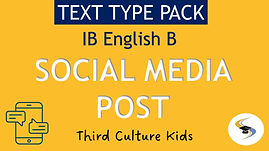Want to ensure your students are not using AI to do their writing for them?
The "How to Write" Student Workbook Packs are all you need.

Low-to-no prep for teachers.
Each workbook spans 4 x 60-minute lessons.
That's 64 lessons completely prepared for you!
Student-focused, student-led, student-friendly.
Student workbooks to make the ENTIRE writing process visible,
so you know no AI was used!
THE COMPLETE STEP-BY-STEP GUIDE to each TEXT TYPE.
If you would like a FREE workbook to try before you buy, please click here
OR
watch the video overview by clicking the button below.
For an overview of the suggested lesson plans, scroll down or click here.

WORKBOOK PART 1
1. Students are introduced to a jumbled version of the mentor text / exemplar text that they will study. They then have to sequence the various elements correctly.
2. Students are then shown the stimulus prompt and have to justify why a particular text type is the most appropriate to fulfill the requirements of the task.
3. They are then shown the actual mentor text.
4. After reading the mentor text, students are asked to complete comprehension questions about it.
5. Then they are asked to label the features of that text.
6. After that, they are encouraged to determine the function of the punctuation and/or grammar used in the text.
7. Then they analyze the vocabulary of the text using synonym, antonym and meaning questions.
8. Finally, they have to show how the main ideas of paragraphs have been developed and extended.
All of this is handwritten on the pages of the workbook.
WORKBOOK PART 2
1. Students are given a follow-on stimulus prompt for the same text type as the mentor text.
2. Before they can begin writing the text, they have to complete a mini-independent research project to gather information for the content of their writing. All their findings are handwritten on the research pages provided.
3. Using the mentor text, students then do two EXTRACTION tasks - one to collate relevant vocabulary, and one to create sentence frames.
4. Now students use a structured planning page to show how they plan to write the text.
5. They are then given a step-by-step guide to writing the text which has to be done on lined-paper provided by their teacher.
6. Once draft one has been completed, students then need to use the informative checklist to either self-assess or peer-assess the first draft.
7. Using the advice provided by the checklists, students then write their final draft and submit that, together with the workbook, to their teacher.


A VISIBLE PROCESS
The entire writing process, from understanding and using a mentor text, to researching, thinking about, planning, and redrafting is therefore completely visible and should provide students with enough practice to confidently write about each text type in their examinations.
EACH STUDENT WORKBOOK PACK CONTAINS:
- A SL Version – with answer options for Part 1 worksheets
- A HL Version – without answer options for Part 1 worksheets
- A One-page Jumbled Mentor Text Starter – the elements of the mentor text are jumbled up and students need to sequence them correctly
- An Answer Key for Part 1 worksheets.

TEXT TYPES LINKED TO ENG B THEMES
-
An ARTICLE about learning to learn (Human Ingenuity)
-
A BLOG ENTRY about the impact of social media (Identities)
-
A DIARY ENTRY about cultural gaffes (Social Organisation)
-
AN ESSAY about the need to learn writing skills (Human Ingenuity)
-
AN INFORMAL EMAIL about pet euthanasia (Experiences)
-
A LETTER TO THE EDITOR about plastic pollution (Sharing the Planet)
-
A PROPOSAL about improving International Day (Social Organisation)
-
A REVIEW of a fiction book (Experiences)
-
A SPEECH about saving a zoo (Sharing the Planet)
-
AN OFFICAL REPORT about a technology experiment (Identities)
-
A PERSUASIVE BROCHURE about a theme parks (Human Ingenuity)
-
AN EMBEDDED INTERVIEW about making a difference (Sharing the Planet)
-
A NEWS REPORT about being remarkable (Human Ingenuity)
-
A SET OF GUIDELINES about mental well-being (Identities)
-
A SET OF INSTRUCTIONS about learning to learn (Human Ingenuity)
-
A SOCIAL MEDIA POST about Third-Culture Kids (Identities)
SUGGESTED LESSON PLANS
FOR EACH WORKBOOK

























